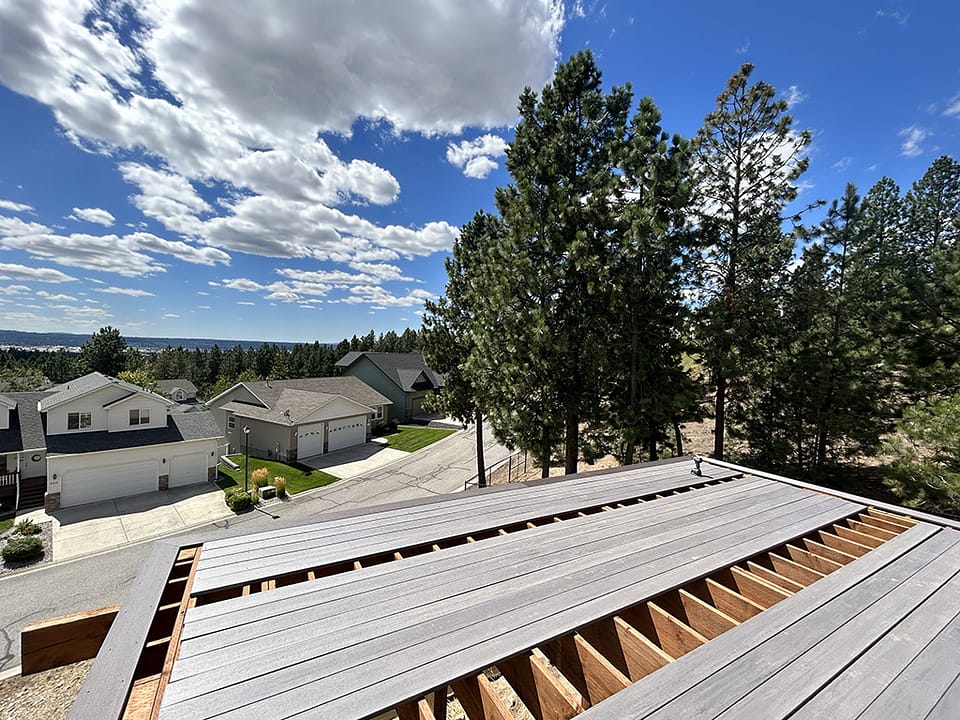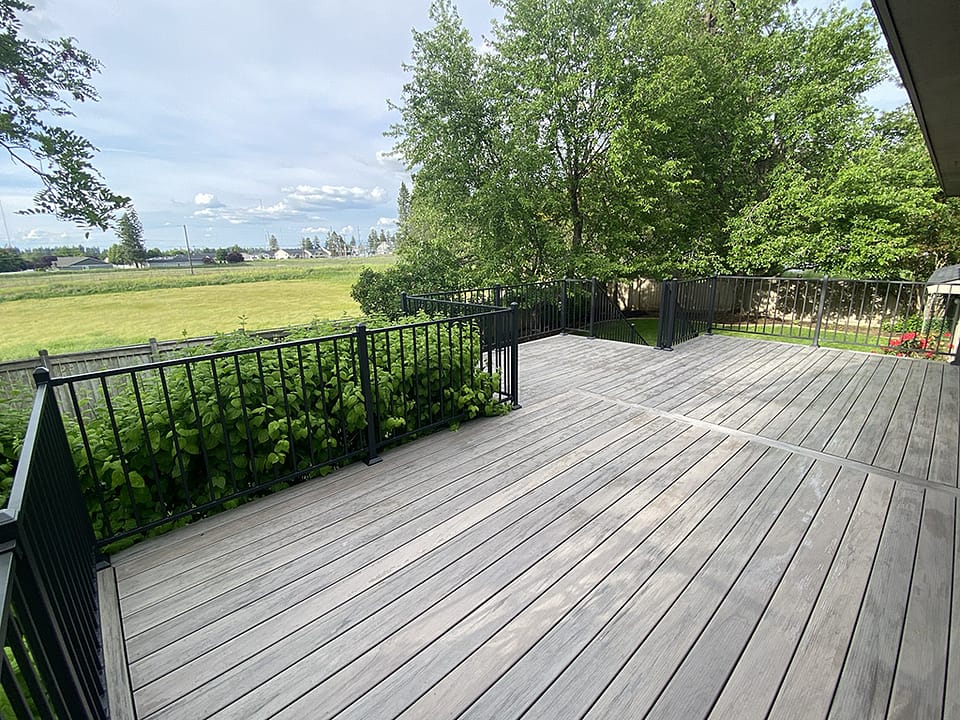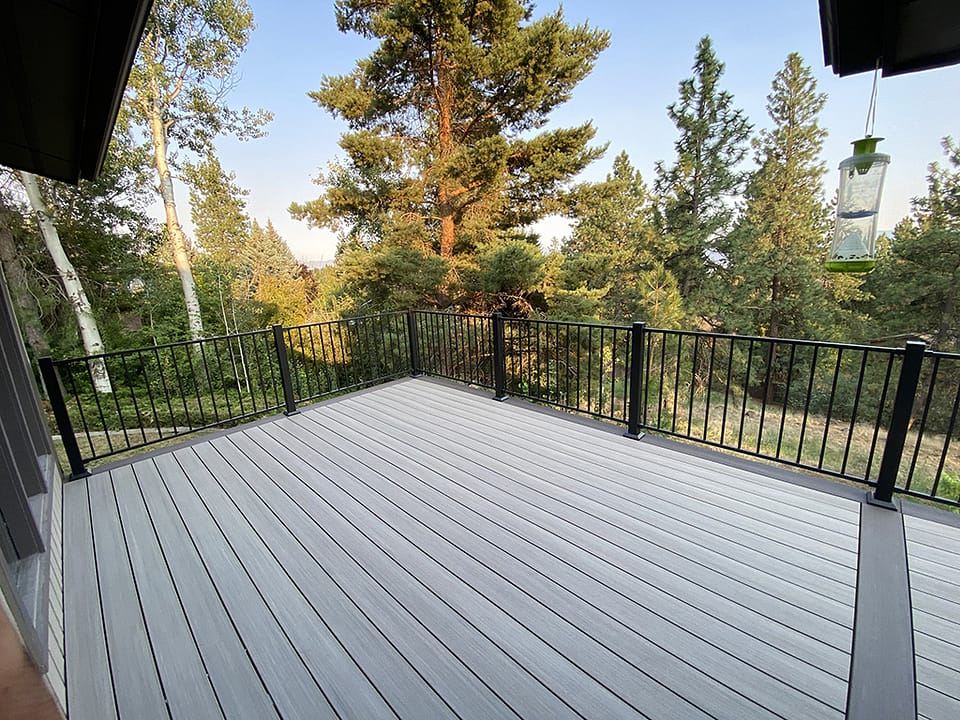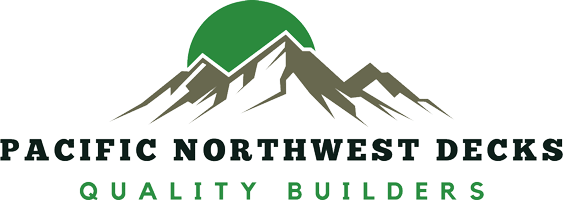
Navigating the TimberTech vs. Trex Decision
If you’re planning to build a deck this year, one of the first big questions you’ll face is this: Should I go with TimberTech or Trex?
It’s a common debate, and for good reason. Both brands are well-known in the composite decking world, and they each offer a range of product lines that look good on paper. But when it’s your home—and your money—you want real answers based on real experience, not just marketing promises.
At Pacific Northwest Decks, we build decks every week across Spokane and North Idaho. We’ve worked with both TimberTech and Trex for years, and we’ve seen how these materials actually perform once the sun, snow, and time get involved. In this article, we’ll give you everything you need to decide which one’s the better choice for your outdoor space.
Here’s what you’ll learn:
- How TimberTech and Trex compare when it comes to materials, durability, heat, looks, and maintenance
- What real-world homeowners have experienced with each product
- Which one we recommend based on your climate, goals, and budget
Let’s break it all down.

Brand Overview: TimberTech and Trex at a Glance
Trex
Trex helped pioneer the composite decking category in the 1990s. Today, their product lineup includes:
- Trex Enhance: Affordable composite boards for budget-conscious projects
- Trex Select: Mid-tier boards with more color variety
- Trex Transcend & Transcend Lineage: Their premium options, offering improved durability and heat resistance. (Lineage is still composite, but features reflective shell technology.)
Trex boards are made from 95% recycled materials and capped on three sides.
TimberTech
A division of The AZEK Company, TimberTech offers:
- TimberTech Prime+: A great entry-level composite option with solid performance and popular color options
- TimberTech Reserve: Bold colors and a textured matte finish that mimics hardwood
- TimberTech AZEK: High-performance capped PVC decking that’s lightweight, waterproof, and extremely durable
TimberTech also focuses on sustainability, using up to 85% recycled content. Their boards are fully capped on all four sides.

Material Comparison: What Are These Boards Made Of?
Trex
Trex boards are a mix of recycled wood fibers and plastic. They’re capped on the top and sides to resist stains and fading, but the bottom remains exposed.
TimberTech
TimberTech makes both wood-plastic composite and PVC decking. Their PVC (AZEK) line is 100% PVC, no wood fibers, and features a closed-cell design that blocks out moisture completely.
Why It Matters:
- Moisture Resistance: TimberTech AZEK offers better resistance to mold, rot, and moisture than composite.
Longevity: A fully capped board (like TimberTech’s) will typically hold up better over decades.
Heat Resistance: Do These Decks Get Hot?
If your deck gets full sun in the summer, heat retention becomes a big deal.
Composite Boards
Both Trex and TimberTech’s composite boards tend to absorb and hold heat, especially darker colors. Trex Lineage offers a cooler shell technology, but the core still behaves like typical composite.
PVC Decking (TimberTech AZEK)
PVC boards reflect heat more effectively and stay cooler underfoot. AZEK performs noticeably better here, which is why we often recommend it for full-sun decks or spaces where comfort is a priority.
Bottom line:
- Composite = warm (If your deck gets direct sunlight for several hours a day in the peak of summer, especially in temperatures above 85°F, it can become too hot to walk on barefoot.)
- AZEK PVC = noticeably cooler


Durability and Real-Life Wear: What Happens Over Time?
We’ve removed a lot of older decks—and the difference in how products age is clear.
What We See During Demolition
Trex decks from 15-20 years ago were part of a major recall. Boards swelled, lost their gaps, and began crumbling like wet cardboard. Mold and mildew would take over the entire board, especially in low-ventilation spaces.
Trex did settle a class-action lawsuit over these defects, but many homeowners were left with failed decks and no meaningful compensation.
How That Affects What We Recommend
After seeing those failures and hearing how frustrated homeowners felt, we started shifting exclusively to TimberTech. The fully capped boards and especially the AZEK PVC line have proven to last longer, look better, and hold up with less maintenance.
If we wouldn’t use it on our own homes, we won’t recommend it to you.

Aesthetics: How Do They Look?
Both Trex and TimberTech offer great color variety and woodgrain finishes. If you want your deck to look as close to real wood as possible, TimberTech (especially the Legacy Collection and AZEK) gets a slight edge for realism.
Color fading? Both brands do a good job with UV protection, especially on their premium lines.
Texture? TimberTech has more style variety and realistic embossing.
Real Story: From Frustration to Confidence
We recently worked with a couple in Spokane, Jim and Heather who had a Trex deck installed nearly two decades ago. Over the years, the boards swelled, the surface turned soft and moldy, and the whole deck became an eyesore. Heather told us she stopped inviting people over because she was embarrassed by how it looked.
After we showed them TimberTech AZEK and explained why it holds up better in our climate, they made the switch. A few months later, Heather told us: “I used to hide our deck. Now I actually want people to come over. I’m proud of our outdoor space again, it finally feels like a place we enjoy, not one we’re trying to avoid.”
TimberTech vs. Trex: Side-by-Side Comparison
Feature | Trex | TimberTech |
Core Material | Composite (wood + plastic) | Composite / PVC (AZEK) |
Capping Coverage | 3-sided | 4-sided / full PVC |
Heat Resistance | Moderate (all composites are similar) | Excellent (AZEK PVC offers top-tier heat resistance) |
Mold/Moisture Resistance | Fair | Excellent |
Color Options | 27 colors | 38 colors |
Realistic Texture | Moderate | Highly realistic |
Warranty | Up to 50 years | Up to Lifetime (AZEK) |
Budget Options | Yes | Yes |
Frequently Asked Questions
Q: Is TimberTech better than Trex in hot climates?
A: Yes, particularly the TimberTech AZEK line. It’s made from 100% PVC, which stays cooler underfoot compared to composite boards like Trex, especially in full sun.
Q: Is Trex a bad product?
A: Not at all. Trex has improved a lot over the years, especially with the Transcend and Lineage lines. However, based on what we’ve seen in long-term durability and heat performance, TimberTech tends to outperform it in our climate.
Q: What’s the difference between composite and PVC decking?
A: Composite decking blends recycled wood fibers with plastic. PVC (like TimberTech AZEK) is 100% plastic, making it more resistant to moisture, mold, and heat. It also tends to last longer with less maintenance.
Q: Which decking brand offers more color options?
A: TimberTech currently offers 38 colors, while Trex offers 27. Both have attractive options, but TimberTech provides more variety.
Final Thoughts: Which One Should You Choose?
Both brands can work. But if you’re looking for long-term performance, comfort in the summer heat, and peace of mind, you’ll likely be happier with TimberTech.
We’ve stopped recommending Trex simply because of what we’ve seen in the field and heard from homeowners. TimberTech, and especially AZEK, has consistently proven itself to be more durable, lower maintenance, and more comfortable to use.

Ready to See It for Yourself?
We make it easy to choose the right deck. We’ll bring TimberTech samples to your home, walk you through the differences, and show real photos of how these materials hold up in our climate over time.
There’s no pressure and no pitch, just real advice from a team that builds decks every week and stands behind what we install.
Let’s design a deck that fits your lifestyle, feels great underfoot, and looks incredible for years to come. Experience the Height of Outdoor Living.

